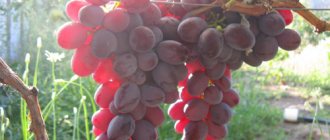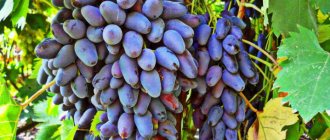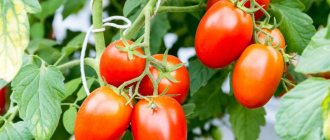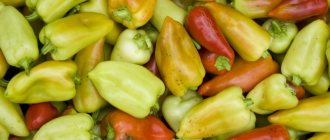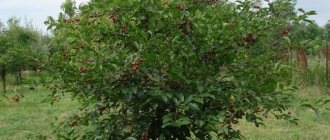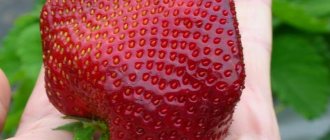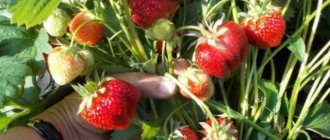Grapes "Lancelot" - variety description, photos, reviews I needed grapes for my grandchildren. I read that it contains a lot of vitamins, so I decided that I should plant it. Since neither I nor my friends have any experience in viticulture, I chose it on a whim.
I looked on the nursery’s website for all the varieties that produce larger clusters and chose the Lancelot grapes. The description of the variety indicated that it can produce up to 3 kg. I have been growing it for 5 years now. Photos and reviews do not deceive, the berries are really large and tasty.
However, I couldn’t get the bunch weight to exceed 2.3 kg. Maybe our climate is a little cold for it, or the soil is not right - I don’t know. The kids like it. The locusts eat everything, there’s not even any left for compotes.
Description of the grape variety "Lancelot"
"Lancelot" is a white table grape with a ripening period of about 135 days. The vine is powerful, grows quickly and requires regular pruning, its color is red-brown. The leaves are bright green, round in shape, and medium in size.
The hybrid is characterized by high yield and impressive size of berries and bunches. The clusters are cone-shaped with a wide base and weigh 1–3 kg. Large oval-shaped berries are densely spaced.
Description of the flower
Fragrant flowers, hermaphrodites, pollinated under any conditions, do not require artificial pollination. The number of inflorescences must be adjusted so as not to overload the bush.
Learn also about table grape varieties such as:
Description of berries
Large berries with a dense, but not thick skin, do not crack from precipitation. The color of the skin is milky-golden, but may turn brownish from excessive exposure to sunlight. The skin is covered with a special coating that protects against adverse weather conditions.
The berry is oval, about 3.5 cm long, 2 cm in diameter, weighs about 15 g. The inside is dense, fleshy with a crunch and juicy. The berries perfectly retain their shape and presentation during storage and transportation.
Taste characteristics
The taste is distinguished by pleasant honey notes intertwined with citrus fruits and a delicate aftertaste, moderately sweet. The taste characteristics do not change even after long-term storage. The berries are very tasty fresh; in addition, they make excellent jams, juices and other desserts. You can also make excellent white wine.
Beneficial features
Berries contain a huge amount of useful substances: vitamins, organic acids, minerals and glucose. Grapes have a beneficial effect on human health. It is recommended for use by patients with asthma and other lung diseases, people with heart disease and blood vessels, and kidney disease.
Sweet berries are a source of natural antioxidants that can boost immunity and charge vital energy.
Description of the variety and its characteristics
The author of the hybrid is the famous scientist-breeder Ya. Potapenko, who has developed more than one variety of crop. The breeder crossed three grape varieties - Podarok Zaporozhye, Ekstaz and a hybrid numbered FV-3-1, resulting in a unique winter-hardy Lancelot.
Despite the fact that the variety is still undergoing testing, it has already managed to win the hearts of winegrowers and winemakers.
Description of plants
The vine variety, powerful and vigorous, will fit perfectly into the landscape of any summer cottage:
- plant shoots, thick and strong, covered with brick-colored bark, calmly support huge clusters;
- leaves, large, five-lobed, have a bright green rich color;
- Lancelot bush is a real fast-growing giant that requires a lot of space;
- shoots ripen almost completely;
- numerous flowers, small, white, collected in panicle inflorescences;
- plants of this species have flowers of both male and female flowering types, therefore, do not require additional pollination;
- flowering occurs in May and lasts about 10 days;
- Plants begin to bear fruit already 2-3 years after planting.
Description of berries and bunches
Lancelot berries are a real masterpiece:
- they grow very large. The weight of one berry can reach 15 g;
- fruit shape - oval, elongated;
- the color of unripe berries is rich green; during the period of full ripening, the color of the fruit changes to golden or milky white;
- juicy and crispy pulp is covered with a dense skin, which is practically not felt when eating;
- The taste of the fruit is simply extraordinary - sweet honey, with a citrus tint.
100 g of grape juice contains:
- sugar - 19 g;
- acids - 7 g.
The fruits do not fall off or crack.
The clusters are large, massive and dense. They have a conical shape. The weight of one brush can reach 1.5 kg, and with quality care, much more.
Medicinal properties
The fruits of this variety not only have excellent taste, but also valuable health properties. The berries contain vitamins and beneficial components that can fight numerous ailments. The pulp of the fruit is rich:
- organic acids that promote normal intestinal function;
- antioxidants that neutralize the effects of free radicals on the body;
- microelements, which improve the functioning of the immune system and strengthen bone tissue;
- linoleic acid, which normalizes kidney function.
Fruit variety:
- can prevent cancer;
- improve visual function;
- heal diseases of the respiratory organs;
- help improve the functioning of the heart and blood vessels.
Usage
Lancelot is an excellent table variety used in winemaking. It makes excellent table white wines. The berries are also delicious fresh. Aromatic juices are prepared from them. The fruits are frozen and added to salads, desserts and baked goods.
Ripening and harvesting dates
The hybrid has a medium-early ripening period. Its growing season is about 130 days. Full ripening of the berries occurs at the end of August - beginning of September. At this time the harvest begins.
If the berries are not removed in time, they will not fall off. At the same time, they will retain their taste and presentation for a long time.
Productivity
This hybrid is characterized by high yield. From 7 to 10 kg of high-quality fruits are collected from one plant. With good care, this figure can be increased.
Shelf life and transportability
Lancelot grapes can be stored for a long time without losing their taste and appearance, which allows them to be transported over long distances. This hybrid is popular among farmers who grow it for sale.
Lancelot grapes - what kind of variety is it?
The Lancelot variety was bred by breeders of the Ya. I. Potapenko All-Russia Research Institute. The main purpose of its creation was to obtain a frost-resistant plant. A detailed study of the properties revealed that the grapes also have other positive qualities.
Note! Tests of the Lancelot variety have shown that it takes root well and bears fruit not only in the southern part of Russia and Ukraine, but also in the Urals and Siberia.
Description and characteristics
Lancelot is a white table grape of early to mid-ripening. The growing season is 130 days.
Gardeners who grow Lancelot grapes describe the variety as follows: vigorous plants with strong shoots, capable of withstanding large clusters. The bushes need spacious areas as they grow quickly. Ripening occurs along the entire length of the vine.
The leaves are medium-sized, bright green and have a serrated edge. The bark is brick-colored. The flowers are white, small and collected in panicle inflorescences.
For your information! The Lancelot variety does not need pollination, since male and female flowers bloom on the vine. Flowering occurs in May and lasts for 10 days.
The first fruiting occurs in the third year after planting. The fruits have a waxy coating, they are milky white when emerging and amber or golden when ripe. The berries are oval in shape and weigh up to 15 g. They are collected in large cone-shaped clusters. The weight of each varies between 800-1200 g. Some record holders reach 2 kg.
The grape pulp is dense and juicy with a small number of seeds. The taste is sweet with a slight sourness. There is no nutmeg taste. Overripe berries rarely crack. Their sugar content is 15%.
Note! Fruits ripening in bright sun develop a blush. To prevent them from getting burns, it is not recommended to remove foliage that shades the bunches.
Advantages and disadvantages
The benefits of the Lancelot grape variety include:
- resistance to drought and frost. Ability to withstand temperatures down to −26 °C;
- high productivity;
- immunity to pests and fungi;
- possibility of long-term transportation;
- the ability of berries to maintain integrity after precipitation.
The Lancelot variety also has disadvantages:
- instability to spring frosts;
- lack of fruiting on the first two eyes, the need to leave up to 4 buds when pruning;
- influence of direct sunlight on fruits, need for shading.
Where is it used?
Lancelot grapes are often grown for sale. The berries, unlike many black and pink varieties, retain their appearance and taste well during transportation. They can be stored for 3 months.
Note! White table wines are made from grapes. The berries are frozen and suitable for making juices and desserts.
Growing areas
Thanks to such features as frost resistance and drought resistance, the Lancelot grape variety takes root well in various climatic conditions. It is grown in the Crimea, the Caucasus regions, Moldova and Ukraine, the central zone of Russia, Siberia and the Urals.
A real treasure - white grapes of the Lancelot variety
What farmer would not want to have grapes on his plot, which will decorate the estate and delight the owners with fresh berries and homemade liqueurs?
And at the same time, it must be of a good quality, well stored, transported, not afraid of Russian winters, and so that it is not required to drive away everyone it can?
Ukrainian breeders have been working on this issue for a long time and are successfully coping with the assigned tasks. A real treasure is the white variety Lancelot.
What type does it belong to?
A new table subspecies of white grapes, ripening period - early-mid . We love winemakers - it is widely used as an integral part of a bouquet of table white wines. The fruits are well stored and transported, while their presentation does not suffer, they never crack.
White table varieties also include Vostorg Bely, Anthony the Great and Arcadia.
The taste characteristics do not deteriorate even after long-term storage. Good for consumption both fresh and in desserts, such as juices, jams, preserves, compotes.
The Count of Monte Cristo, Rapture and Galahad have the same qualities.
Appearance
Bush of high growth vigor. The bunch has the shape of a wide cone, is very large, dense, without peas, and can reach a weight of 1.2 to 3 kg .
The flower is hermaphrodite. The vine is powerful, flexible, brick-colored. The leaves are medium-sized, rounded, rich green.
Descendant of Rizamat, Romeo and Gordey also have bisexual flowers.
History of selection
This “knight” owes his birth to the specialists of VNIIViV named after.
ME AND. Potapenko of the city of Novocherkassk. Obtained as a result of crossing Gift to Zaporozhye and a hybrid of varieties Ecstasy and FV-3-1 .
The properties of the variety are currently being tested in the south of Belarus.
According to the breeders, it should feel good both in the south - Ukraine, Crimea, the Caucasus, Moldova - and in the central zone of Russia, right up to the Ural and Siberian territories.
Lancelot grapes: variety description
Lancelot fully lives up to his name - he is persistent and courageous. He is not afraid of frost ( the minimum minus is 24 degrees ), nor parasites, nor fungi. True, he is afraid of late spring frosts.
It has a sweet, rich taste with distinct honey and light citrus notes. Sugar content of Lancelot is up to 19 g/cc. cm . Acidity level - 7 g/l . The yield of this variety is very high, the vine ripens to almost its entire length, so in order not to overload the bushes, it is necessary to prune by six to eight buds, leaving a norm of approximately 35 buds per bush .
Berries are not afraid of rain. At the same time, Lancelot will not mind additional care - watering and fertilizing. Not all farmers like the “tanning” of the berries in the sun, therefore, in order to preserve the moon-golden appearance, it is not recommended to get rid of shading leaves.
Photo of Lancelot grape variety:
Diseases and pests
Grapes of this variety are a tasty target for wasps and birds. Striped aggressors can either be destroyed or scared away. Supporters of radical methods should use sticky traps without chemical amber and insecticides.
For those who do not want to kill sedges, special fine-mesh mesh bags , in which hanging bunches are packaged. They will allow the grapes to breathe and at the same time, will not allow hunters to approach them.
For sparrows, tits and magpies, strong reinforced nets are suitable, which would create a barrier for the birds, preventing them from getting tangled. The purpose of such a net should be precisely protective - the farmer needs grapes, not dead and beating birds.
According to breeders and gardeners, Lancelot is not afraid even of the leaf roller. Resistance to phylloxera is being studied.
Lancelot is a real find for novice farmers, as it does not require complex care, as well as for those who want to get a harvest quickly. It is juicy, sweet, good both fresh and in wine.
As for common grape diseases, for example, oidium, mildew and various types of rot, prevention in this area will never hurt.
It is also worth arming yourself with knowledge about anthracnose, bacteriosis, chlorosis, rubella and bacterial cancer. This will help you get a good harvest and protect your plants.
Useful video
Find out more about the knightly grape variety "Lancelot" from the video below:
https://youtu.be/21gmSgDDQPQ
If you find an error, please select a piece of text and press Ctrl+Enter.
Characteristics of Lancelot grapes
The hybrid has a mid-early ripening period; 125–130 days pass from the appearance of buds to cutting. The bush without shelter can withstand frosts of up to 24 degrees; some gardeners say that with good snow cover, Lancelot withstood a short-term drop in temperature to 27 degrees.
Resistance to diseases is good, however, in some years partial damage by oidium is observed. Of the pests, sparrows are dangerous, and wasps are of little interest to berries with thick skin. Late spring frosts can also harm Lancelot; a frozen vine does not recover well.
Description of the bush, bunches and berries
The bush is powerful, tall, develops quite quickly, the vine is flexible, brick-colored. The leaves are medium-sized, slightly dissected, dark green. The ripening of the shoots is excellent. The flowers are bisexual, the hybrid bears fruit well without pollinating varieties. The bunch is cone-shaped or wide-conical, large and dense, from 800 grams to 1.2 kilograms; in rare cases, the clusters can weigh up to 3 kilograms.
The berries are large (37x26 mm), oval with a blunt tip, about 12–15 grams, light green-golden or white-golden, amber due to a light waxy coating and have a milky tint. The skin is medium thick, strong, the flesh is dense, crispy, juicy and meaty, there are few seeds. No peas are observed even when the bush is heavily loaded with berries.
The taste is pleasant honey-citrus (without nutmeg aroma), sugar content is about 19%, and the acid level in a liter of juice does not exceed 7 grams. The berries practically do not crack when overripe or waterlogged; isolated specimens that burst quickly rot. In the sun, a blush forms on the skin, which slightly spoils the presentation of the brushes.
Yield indicators, use
The bush begins to bear fruit in the third year, the yield is very high, the vine ripens to almost its entire length. In order not to overload the plant, it is necessary to prune by 6–8 buds, the norm would be 35 buds per bush. When excess inflorescences are cut off, the berries ripen a little earlier than the originally stated date. An adult bush is capable of pulling a load of up to 50 kilograms or more. The amount of harvest depends on many factors (age of the vineyard, growing region, weather conditions and pruning).
Indoor chrysanthemum in a pot: care at home, planting and replanting, features of seasonal growing of the plant
The brushes do not lose their appearance during transportation, only overripe berries fall off, the commercial characteristics of Lancelot are very high, it is often grown for sale. The bunches are stored well in a cool place for up to 2.5 months and do not lose their appearance or taste. Purpose: dining.
Appearance
Bush of high growth vigor. The bunch has the shape of a wide cone, is very large, dense, without peas, and can reach a weight of 1.2 to 3 kg .
The berry is large, oval, milky white-golden and golden in color, weighing about 15 g . The skin of the fruit is dense, of medium thickness. The pulp is juicy, fleshy, dense.
The flower is hermaphrodite. The vine is powerful, flexible, brick-colored. The leaves are medium-sized, rounded, rich green.
Descendant of Rizamat, Romeo and Gordey also have bisexual flowers.
Pros and cons of the Lancelot variety
Any variety has its advantages and disadvantages, Lancelot grapes are no exception. Among the main advantages are:
- excellent taste of fruits;
- attractive appearance of a bunch of grapes;
- large brushes and fruits;
- increased resistance to low temperatures;
- this grape variety is practically not susceptible to diseases and pests;
- if necessary, the brushes can remain on the vine for a long time after ripening;
- can be transported over long distances.
The high density of berries is both a plus and a minus of Lancelot grapes. For example, thanks to the dense cluster of berries on the cluster, the fruits do not wrinkle during transportation, but at the same time, the peel prevents uniform ripening.
Features of planting and growing grapes
With proper planting and care, up to 10 kg of fruits are harvested from one bush in the southern regions and about 7 kg in the central zone.
Landing dates
The most favorable time for planting grapes is autumn, mid-September. During the winter months, young plants take root and gain strength. Spring, as a time for planting seedlings, is dangerous due to the onset of night frosts. If the bushes suffer from them, they often do not resume growth. Despite this, many winegrowers prefer spring planting, and to protect them from the cold, the grapes are covered with film material at night.
For your information! If agrofibre is used for covering, it can be left during the day. It allows air to pass through well.
Site selection and soil preparation
It is recommended that the variety be allocated to windless, open areas of fertile soil warmed by the sun's rays. The hybrid is characterized by strong growth, so when planting in groups, you need to leave 2-3 m of distance between plants.
Before planting the bush in open ground, the area is prepared in advance. When planting in spring, this work is done in the fall. The following nutrient substrate is added to the soil:
- peat - 30 l;
- wood ash - 2 kg;
- humus - 20 l;
- fertile soil - 30 l;
- potassium - 150 g.
How to choose the right seedling
The seedling should be about half a meter long, have a developed root system and mature buds. Before purchasing, it is important to inspect the bark for damage, stains, or dry areas. Using scissors, the roots of the seedling are shortened to a length of 15 cm, after which they are placed in a liquid clay solution.
Planting process step by step
When planting a crop in open ground, perform the following steps:
- The area is dug up, removing weeds.
- Dig planting holes. The optimal size is 80x80x80 cm.
- They are filled to a third of the depth with fertilizers and fertile soil.
- The seedling is carefully buried to 50 cm, straightening the roots.
- Water generously.
Why do you need to care for grapes?
As soon as the plant reaches its second year of life, it is necessary to regulate the growth of the vine, form a bush, water and feed the grapes. If you carry out all care activities in a timely manner, a healthy vine will develop, from which you can reap a good harvest in the future. Care includes the following:
- Breaking off shoots. The first procedure should be carried out in the spring, when inflorescences and tendrils appear. Weak shoots and shoots must be removed. After the berries are set, the procedure must be repeated.
- Pinching shoots. Thanks to this technique, their growth is inhibited, and the flow of nutrients is redirected to the inflorescences. Pinching should be done a few days before flowering. Shoots twenty to twenty-five centimeters long are shortened by two leaves.
- Stepsonning . During the growing season, stepsons are removed from annual shoots. This is necessary to thin the bushes and preserve nutrition in the supporting shoots. The stepsons are not removed entirely, but are only slightly pinched at the level of the second leaf.
- Coinage. By using this technique, the grape vine will be better prepared for winter. This event takes place in the month of August, when the shoots stop growing. This method of caring for grapes involves trimming the apical part of the shoots. It is trimmed to approximately forty centimeters with six to eight leaves.
- Grape pruning. If this is not done, the vine will grow greatly. The berries will be small. Pruning of grapes occurs at the end of autumn, before the onset of frost, and in spring, before the buds open. In the fall, fruit-bearing shoots (vines) are pruned, and in the spring, sanitary pruning is carried out. It consists of removing damaged and rotten parts of fruiting shoots.
Main features of the variety
A review of the description of the Lancelot grape variety must begin with its origin. The culture is a hybrid. The grapes were obtained by crossing Gift to Zaporozhye, FV-3-1 and the Ecstasy variety. The result of selection was the early hybrid Lancelot, which produces a harvest approximately 130 days after the buds awaken.
The bush of the Lancelot variety is characterized by a spreading, vigorously growing vine. The flowers are bisexual, which promotes self-pollination. During the season, the vine manages to ripen almost its entire length.
The clusters grow large, conical in shape with tightly packed berries. Typically, the average hand weight varies from 0.9 to 1.3 kg. Good feeding allows you to increase the weight of the bunch up to 3 kg. The shape of the berries is cylindrical, turning into an oval. The weight of one fruit is about 14 g. The average berry length is 31 mm, width is 22 mm. The skin of Lancelot grapes is light green and turns white when ripe. In the sun, the berries get tanned.
The structure of the pulp is fleshy, the taste is sweet with a moderate presence of acid. When eating the berry, a honey aroma is felt. The skin is so strong that it does not crack when the soil is very waterlogged, however, when chewing the fruit, it is practically not felt.
The Lancelot variety is characterized by high unlimited yield. To reduce the load on the bush, some of the brushes are removed even before flowering begins. In winter, Lancelot grapes can withstand frosts down to –24°C. The variety is resistant to fungal diseases, but preventive measures must be taken.
A better video to help you recognize Lancelot grapes:
History of selection
This “knight” owes his birth to the specialists of VNIIViV named after.
ME AND. Potapenko of the city of Novocherkassk. Obtained as a result of crossing Gift to Zaporozhye and a hybrid of varieties Ecstasy and FV-3-1 .
The properties of the variety are currently being tested in the south of Belarus.
According to the breeders, it should feel good both in the south - Ukraine, Crimea, the Caucasus, Moldova - and in the central zone of Russia, right up to the Ural and Siberian territories.
Positive and negative qualities of the variety
Having finished considering the description of the Lancelot grape variety, photos, reviews, it is worth summing up the presence of positive and negative qualities of the culture. The benefits include:
- excellent taste of berries;
- beautiful presentation of the bunches;
- large clusters, large berries;
- resistance to frost, fungal diseases and pests;
- the brushes can hang on the vine for a long time and can be stored and transported.
The greater density of berries on a bunch can be attributed to advantages and disadvantages. Due to the dense cluster of fruits, the clusters of the Lancelot variety do not wrinkle during transportation. However, this same density prevents the berries inside the bunch from ripening evenly.
Advantages and disadvantages of the variety
- Advantages of Lancelot:
- high frost resistance, up to –24°C;
- high productivity;
- immunity to most diseases;
- good presentation, large bunches and berries;
- wonderful taste and aroma;
- long shelf life without loss of taste;
- grapes do not crack due to precipitation;
- taste and external qualities are not affected during transportation.
- Flaws:
- young shoots do not tolerate frosts in late spring;
- the berries change their color (the presentation deteriorates) when exposed to excessive sunlight;
- it is necessary to regulate the number of bunches.
Diseases and pests
Lancelot is resistant to most existing grape diseases. It practically does not suffer from oidium or mildew, however, experienced winegrowers recommend treating plants in early spring with a 1% solution of Bordeaux mixture (per 10 liters of water - 100 g of copper sulfate and 150 g of lime) as a preventative measure.
Treatment is carried out once in early spring before flowering begins.
Also, the variety is not afraid of numerous pests, however, birds and wasps love to feast on the fruits of this species. Wasps are combated using special traps with sweet bait, or mesh bags are placed on the grapes. Plants are protected from birds with strong nets. They are placed so that birds cannot get entangled in them.
It is not yet known how the hybrid reacts to phylloxera (grape aphids). The influence of this pest on this type of grape is only being studied.
Pest control and disease prevention
Lancelot grapes are resistant to diseases. Its resistance to fungal infections is estimated at 2.5 points, to oidium and gray mold - at 3.5 points. As a preventive measure, mulching and spraying are carried out:
- To prevent oidium, fungicidal preparations are used, for example, foundationazole;
- Before flowering, a 1% solution of Bordeaux mixture is used.
Lancelot is a clear example of a variety with good survival rate in not the most favorable climatic conditions and minimal care requirements. This sets it apart from many new hybrids. It is suitable for cultivation by beginning gardeners and is a worthy specimen in the collections of experienced winegrowers due to its good taste, yield, and durability.
Climate and cultivation regions
Due to its high frost resistance (up to -26 degrees), excellent drought resistance and endurance to various climatic conditions, the variety is grown not only in the southern regions, but also in temperate latitudes, up to the Urals and Siberia, however, it is worth considering that plants do not tolerate spring weather well. frosts.
How to treat rust on a pear - treatment tips, main signs of the disease and recipes for restoring the harvest. Schemes for processing, feeding and fertilizing pears (120 photos)
How to care for the Lancelot variety
General requirements for cultivation and care:
- timely watering;
- regular application of fertilizers to ensure high yields;
- autumn pruning;
- creating shelters for the winter.
Watering and fertilizing
The regularity of watering depends on weather conditions. The volume of water required is about 50 liters per 1 m² of soil. If there is a lack of moisture, the inflorescences and ovaries die. Water is poured at the root.
The periods when plants especially need moisture are flowering and ripening of berries. Stop watering the grapes 3 weeks before harvesting the fruit.
Note! After watering, the soil is loosened and mulched with sawdust or straw.
Plants are fed regularly: young vines monthly, mature ones at the beginning and end of the season. Organic matter (humus, manure or wood ash) is used as fertilizer. To obtain sweet large berries, mineral compositions with a predominance of phosphorus and potassium are added.
Bush formation and pruning
Pruning is carried out in the fall before fruiting begins.
- Annual bushes with a single shoot are pruned into 4 eyes. Plants with two shoots are cut 2-3 cm above the second bud.
- Two-year-old vines are pruned with 2 eyes.
- Three-year-old bushes are left with two vines. The lower one is cut into 2 eyes, 7-15 buds are left on the upper one. Other shoots are removed.
Garter
Thanks to the garter, compact plants are formed, ensure normal development of the vine, improve ventilation and reduce the incidence of disease, and prevent fungal infections.
The best period for this work is early spring, the beginning of sap flow. At this time, the vine is strong, but retains its flexibility. It is necessary to complete the garter before the buds open, so as not to damage the tender young shoots.
Important! In the summer months, only new shoots are tied up so that they do not create obstacles to the ripening of fruits.
Shelter for the winter
Despite the frost resistance of the variety, gardeners cover it for the winter. They do it like this:
- The vines are removed from trellises or nets and tied.
- Floorings are constructed from straw or wood, on which the shoots are laid.
- Dense material is placed on top and sprinkled with soil.
Features of care
The Lancelot variety, like other grapes, requires standard care procedures. From the beginning of April to the end of October, the bushes are regularly watered. The frequency depends on weather conditions. Water is poured under the root of the grapes. After the liquid is absorbed, the ground is loosened with a hoe to avoid the formation of a crust. Adding mulch gives good results. Straw, sawdust or peat prevent grass from growing, prevent moisture evaporation, and are also good organic fertilizers.
Mandatory watering of Lancelot grapes is carried out before flowering, as well as during the pouring of berries. At least 50 liters of water are poured onto 1 m2 of land. Lack of moisture during this period threatens the shedding of inflorescences and ovaries. About 3 weeks before harvesting, watering is completely stopped.
Preparing for wintering Lancelot similarly cannot be done without abundant watering. The amount of water per 1 m2 is increased to 100 liters. The abundance of moisture makes it possible for the vine to stock up on useful substances for the winter.
The Lancelot variety loves feeding, for which it thanks for its large clusters. Organic matter is considered the best fertilizer. Gardeners use rotted manure, humus, compost and add wood ash. Feeding grapes with mineral fertilizers containing potassium and phosphorus helps increase the sweetness and size of the berries. Young bushes of the Lancelot variety are fertilized monthly. Mature grapes are usually fed at the beginning and end of the season.
Under good weather conditions, Lancelot bunches will ripen in early September. The amount of harvest depends on care and climatic conditions. In the southern regions, up to 10 kg of grapes are harvested from a bush. For the central strip, a yield of up to 7 kg per bush is considered normal.
The Lancelot variety is considered frost-resistant, but in cold regions the vine is covered for the winter. The grape branches are removed from the trellis, tied with rope, and placed on boards or a bed of straw. The top of the vine is covered with dense material and covered with earth.
Before sheltering, the grapevine must be pruned. Lancelot bushes are vigorous and need to be shaped. The advantage of autumn pruning is that the procedure is less painful. By this time, sap flow slows down, and the grapes lose less nutrients. In spring, it is better to prune frozen and damaged shoots.
On young Lancelot bushes, 3–4 eyes are left on the vines. They do not give birth, but are used to form a bush. On mature grapes, lashes with 8 eyes are left. The bush forms from 3 to 8 fruiting sleeves. The maximum number of eyes on an adult grape is 35. It is not advisable to leave a larger quantity. Overloading the bush will only reduce the yield and deplete the vine.
Reviews about the variety "Lancelot"
Many gardeners and winegrowers speak well of the qualities of Lancelot. The variety is suitable for growing even for beginners. It does not require any special effort, money or time for care. The grapes are resistant to diseases and do not burst from high humidity.
The variety always produces excellent harvests of tasty berries, which can be stored in a cool place for several months. “Lancelot” is tasty not only when eaten fresh - the berries can be used to make homemade preparations, jam, juices and aromatic white wine.
So, we can conclude that the Lancelot variety has many advantages and has almost no disadvantages. When growing it, you can always get a high yield by properly caring for the vine and doing simple procedures on time. This plant can be a wonderful decoration for your garden and home and provide tasty and healthy berries.
Beneficial features
The benefit of grapes lies in the content of large amounts of vitamins, minerals, soluble acids and other valuable substances. It is impossible to list all the properties that bring health benefits, so let’s name a few of them:
- The fruit contains resveratrol, which effectively fights lung diseases and asthma.
- The peel of the fruit and seeds contain substances that help eliminate heart and vascular diseases.
- The content of organic acids helps prevent constipation.
- Grape juice contains natural antioxidants that energize the body.
- Linoleic acid and other substances help remove fluid from the body, facilitating kidney function.
- The fruits have strong anti-cancer properties.
- Antioxidants in grapes can prevent visual impairment.
- Thanks to the content of microelements, the strength of bone tissue increases and immunity increases.
Reproduction of the variety
Grape growers resort to various methods of crop propagation. The most common is cuttings. It is this method that allows you to obtain plants that completely replicate the qualities of the mother specimens.
Reproduction requires a considerable amount of time and takes place in several stages:
- Procurement of material.
- Storing cuttings.
- Germination.
- Planting in open ground.
Cuttings are harvested in the spring before sap flow begins or in the fall. In the first case, green chibouks are obtained, which can be used during the current growing season.
In autumn, after the leaves have fallen and the harvest is harvested, woody cuttings are cut off. They are stored throughout the winter and germinated when spring arrives.
Note! Experienced winegrowers note that the survival rate of green cuttings is better.
Care
Lancelot is cared for in the same way as other varieties of this crop:
- plants need watering. Twice a season the soil around the vine is charged with moisture. This is done in early spring, before the growing season begins, and in the fall, before the onset of cold weather. To do this, you need to contribute per 1 sq. m up to 120 liters of water. The bushes also need to be watered during the summer. The first time moisture is applied after the plants have flowered, the second application of moisture is carried out before the fruits begin to ripen. At least 50 liters of water must be poured under each bush. If the summer is dry and hot, then the amount of watering is increased;
- grapes need fertilizing. In the spring, as a rule, organic fertilizers are applied - humus, chicken droppings, old cow manure. Young bushes are fed with nitrogen-containing substances. In the fall, after harvesting, in addition to organic fertilizers, phosphorus and potassium fertilizers are added;
- bushes require annual pruning, which is carried out in the fall. The shoots are shortened so that no more than 35 eyes remain on each plant;
- the soil around the vine is kept clean, freeing it from weeds and organic debris, in which pathogenic bacteria, fungal spores and pest larvae can multiply;
- to ensure constant access of oxygen to the root system, the soil around the bushes is periodically loosened;
- Despite the high frost resistance, the vine must be covered for the winter. It is removed from the support, placed on the ground and covered with spruce branches or agrofibre, and then sprinkled with soil.
Pruning young plants
Three-year-old bushes should be pruned only in the spring, as they do not bear fruit yet. The grapes are pruned according to a special pattern.
- If an annual bush has two shoots, it is cut off above the second bud by one or two centimeters, and if there is one shoot - by four eyes. This is how a bush is formed into four shoots.
- A two-year-old bush is pruned with two eyes, and the long shoots (vines) that have grown are covered for the winter.
- When pruning a three-year-old bush, they immediately lay down the branches on which the fruits will grow. For this, only two vines are left, the rest are removed. The lowest shoot is cut into two eyes, and the top shoot is cut to such a length that seven to fifteen buds remain on it. Mature Lancelot grapes, reviews of which are positive, are pruned into six to eight buds, since the first two do not bear fruit. Thirty to thirty-five eyes are left on the bush.
Disease Prevention
A special feature of the Lancelot grape variety is its resistance to dangerous diseases: mildew and oidium. However, preventive measures should not be ignored. Before flowering, grape bushes are sprayed with a 1% solution of Bordeaux mixture.
Insects and birds pose no less danger to ripe berries. The tough skin of the berries makes it difficult for wasps, but they can chew it if they want. With the appearance of sweet juice, the fly flies together with the wasps. Traps made from plastic bottles help get rid of the enemy. Containers without stoppers are hung with ropes from a trellis, and sweet liquid is poured inside. The grapes are covered with nets from voracious birds.
The video provides an overview of Lancelot grapes:
Productivity
The Lancelot grape is a hybrid and belongs to the early ripening varieties. The growing season is about 130 days after buds appear. Harvesting begins in the second half of August or early September.
This grape variety is characterized by high yield, as a result of which it is grown not only for personal purposes, but also for further sale. From one grapevine you can collect 7-10 kg of fruit. If you provide Lancelot grapes with proper care, the amount of harvest will be significantly higher.
How did grapes appear in Russia?
Grapes were known already in the 3rd-4th millennium BC. Since it is a southern crop, it was cultivated in regions characterized by a mild climate with high temperatures and a long warm period. In Russia, grape growing began in the 17th century, when for the first time vines were planted in the open air in Izmailovo, Moscow Region.
Already in the 18th century, the Kremlin gardens were planted with grapes. Here the plant was a cover crop. At that time, scientific work to eliminate the problems associated with growing grapes was not carried out. Therefore, the bushes often froze and had to be replaced.
The beginning of a new breakthrough in viticulture was laid by Michurin. Today, our contemporaries-breeders have developed many varieties and hybrids of the crop, including Lancelot grapes, for cultivation in various regions of Russia. In warm areas it is grown outdoors.
Harvesting and storage
Harvest in late August or early September. Remove the bunches carefully, without touching the berries. Damaged, dry, rotten fruits are removed. The storage room should be free of foreign odor so that the berries do not absorb it. Humidity - 80% and temperature +1...+ 5 C. Brushes are stored in a suspended state, in boxes, on racks. It is allowed to keep grapes in the refrigerator.
Bunches of grapes are stored for 2.5 months in a cool place, without losing taste or appearance, even when transported over long distances.
